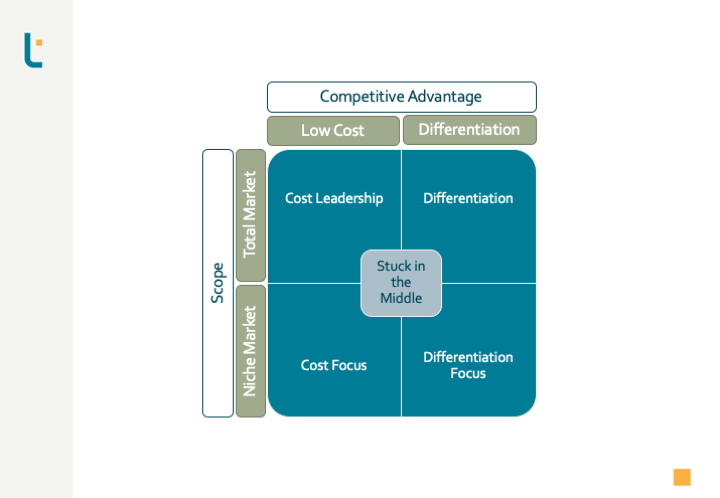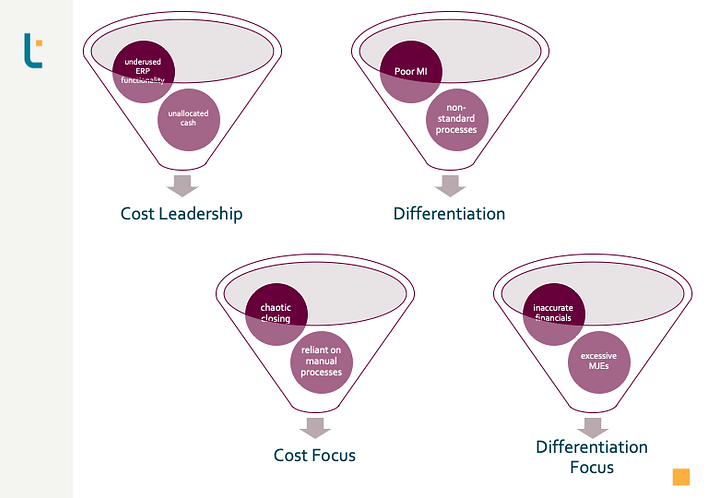Strategy: How to Supercharge Finance Transformation

AUTHOR: JENNIFER LOUGHRIDGE
PRINCIPAL CONSULTANT
Jennifer is a Senior Executive Finance professional with 17+ years of global experience. She specialises in Finance Transformation and Continuous Improvement, with particular expertise in Strategy, Performance Management, Business Partnering, Commercial Decision-Making, Corporate Governance and Valuation.
jennifer.loughridge@loughridgetransformations.com
Our introductory post in this series began with an overview of the Nine Steps to Finance Transformation. This post will focus on the first of the nine steps: Understand Your Business. First, we will look at the importance of strategy and then why it is an essential step. Finally, we will look at what is critical for Finance Transformation.
Is Strategy an Essential Step?
Perhaps it is an obvious place to start, but organisations sometimes overlook it. It is especially the case when taking an off-the-shelf product or considering only a small component of a more extensive transformation. However, it is worth doing, even if only approached with the lightest of touches. Skipping this step means you risk missing the necessary input to make vital decisions in subsequent steps, such as the degree of sophistication in potential solutions or the standardisation required by your function. So even if this step only takes thirty minutes of thinking, we recommend that you do at least that.
This step is essential if you are embarking on a significant Finance Transformation. Without it, the Transformation will lack direction, and you may make wasteful cost and resource decisions.
If your organisation already has a well-understood and communicated strategy, you can pick that up and use it to guide you. Alternatively, you might need to work with what there is – however well- or less well-defined.
Which Strategy Outcomes are Required?
As mentioned above, a light-touch approach may mean no more than thirty minutes of reflection. In other situations, you might find a facilitated workshop or even a series of workshops is required. Often, a third party, such as Loughridge Transformations, can be very impactful in running such sessions. In addition to providing an external lens, a third party can create space for CFO and other functional leaders to focus on the questions at hand.
It is also often worth leveraging external expertise to ensure that the focus is on the parts of the strategy most relevant to the later steps in Finance Transformation. If that focus is missing, this strategy step can feel like a tick-box exercise rather than value-adding, as the needed inputs for the later steps will be overlooked.
Loughridge Transformations can tailor a workshop to fit the scale and complexity of the transformation – and you may wish to combine it with the introductory session mentioned in our last post.
How to use your Business Strategy?
The answer, of course, is dependent on what your Business Strategy is!
However, to help explain the approach, we will refer to Porter’s Generic Strategies. If you are unfamiliar with Porter’s model or want to look into it in more detail, you will find it in many strategy textbooks. His original publication is from 1985: Competitive Advantage: Creating and Sustaining Superior Performance.

Cost Leadership
We start with the top-left quadrant – cost leadership.
An organisation in this quadrant will aim to have efficient, standardised processes with high accuracy.
Technology (including digitisation) will be deployed where it supports those goals but not more.
The organisation will be lean and cost-effective, potentially focusing on innovation and improvements that maintain or improve its cost leadership position.
Differentiation Focus
We move to the bottom-right quadrant – differentiation focus. Here, it depends on what the organisation has defined as its differentiator. Let’s consider, as an example, excellent customer service.
The organisation, here, will also aim for efficient and standardised processes with high accuracy. However, process flexibility may be allowed where it improves the customer experience.
Technology will likely mirror processes, and solutions will focus on enabling a positive customer experience.
Given the process flexibility, the organisation may have pockets that are not so lean to benefit customer service.
The organisation will likely also have space to look at innovation or improvement that maintains or improves its differentiators.
Differentiation
We then move to the top-right quadrant. Here, the organisation is looking at a mass-market position. The trick is to get the right balance on the pieces described above. This balance ensures the organisation achieves the best of both rather than the worst of both!
The Impact of Strategy on the Function
You may already see how the strategic make-up in each scenario influences both the Finance Function’s scope and delivery. Consequently, this make-up is a critical feed into the scope and design of a Finance Transformation programme.
Using Strategy on a Smaller Scale?
Perhaps it is now clearer why strategy is essential in a larger-scale programme. But why does Loughridge Transformations advocate not skimping on the strategy step when the activity is smaller-scale? Let us look at a practical example to illustrate its value.
A Practical Example
You have received the audit report from your external auditors with audit findings, including:
- weak control framework
- lack of adequate risk mitigations
- and more.
As a senior manager with accountability in this area, you are responsible for resolution. At first glance, it might seem the most obvious course of action is “simply” to review the audit findings, re-design the control(s) and subsequently deploy the updated controls. Indeed, your primary focus might be to “just” ensure compliance. Indeed, compliance is a strong driver if your organisation is subject to a regulatory framework like Sarbanes-Oxley.
However, the problem is that this approach is a short-term fix because no one has examined the underlying causes of the control failures. Without looking at the root causes, the solutions deployed are not likely to be successful or sustainable.
By taking the time to understand the strategic positioning, you will spot symptoms more readily and get to the real issues you need to resolve.
Again, an external and experienced pair of eyes, such as we have at Loughridge Transformations, can be invaluable.
Using Strategy to Spot Symptoms
If you want to tackle the audit findings successfully and sustainably, you will need to understand what is causing the control failures.
It might be that processes are not standardised or that manual processes are not robustly automated. You might even have functionality in the ERP or other technology available but not used. It is more common than you might think. It is easier for individuals to continue doing what they have always done than to use something new!) There may even be gaps in functionality, and the ERP is no longer fit-for-purpose.
Perhaps the design quality of your controls is top-quartile, but the deployment did not consider change management properly. The result is that the controls are operating ineffectively – even if the team designed them effectively.
Using Porter’s Generic Strategies, we highlight typical symptoms of each quadrant. Knowing in which quadrant the organisation sits gives you a head start in understanding the symptoms of those control failures.

A Familiar Story?
There is something else that we have come across frequently. An organisation may have state-of-the-art products and/or services to customers locally or globally and have good financial performance. However, it is not a given that the Finance Function is in good health. It is not uncommon to find finance departments in a constant fire-fighting mode. Sooner or later, a fire-fighting finance department will affect the overall organisation. Examples could be:
- suppliers are not paid on time
- unreconciled bank statements lead to unallocated cash stemming from customer payment
- an inability to produce reliable and meaningful Management Information for decision-making
- a chaotic closing process failing to provide accurate financial reports
- excess manual journal entries due to a high number of accounting corrections.
The list can be a long one. Moreover, these items are symptoms that help identify and address the actual root cause. If not resolved, these symptoms will eventually push the organisation into a quadrant that is not the chosen strategic positioning or, worse, “stuck in the middle”.
Besides, a Finance Function partly or wholly in fire-fighting mode is not a happy place to work. If the situation is left untreated, staff will become demotivated. Attraction and retention issues will build on the existing problems, leading to a downward spiral.
…and the Good News?
The good news is that once the strategic positioning is understood, the symptoms assessed, and root causes identified, you are then on the road to improving the situation and implementing successful and sustainable solutions. Again, an external resource, such as Loughridge Transformations, can tailor-make one or more workshops or assessments, which will crystallise today’s reality.
From that, a prioritised list of short-term “must-do” items, medium-term “needed” or “highly desired” items, and long-term “edge-over-competitors” items can be compiled. As always, Loughridge Transformations’ scope can be tailored to suit the organisation’s needs and budget. That can range from part-time resourcing to a full-blown team of experienced, individual Subject Matter Experts and end-to-end delivery.
Interested in More Finance Transformation?
Our next post will focus on the second step – determining the finance functional fit. We will introduce our five-part model and look at the modular aspect of the Loughridge Transformations method.
Find Out More About Working with Loughridge Transformations
Get the Latest from Loughridge Transformations
Subscribe to Our Blog
Have you missed some of the other posts in this series? Find them here:
- Finance Functional Fit: The Most Critical Scope Definition You Need
- Strategy: How to Supercharge Finance Transformation
- Reviewing the Nine Steps to Finance Transformation
- Sustain the Change: Finance Transformation to Last
- Deployment for Finance Transformation: Ensuring a Successful Go-Live
- Delivery – Design and Prepare for Robust Finance Transformation
- Finance Transformation: Understand The Context to Secure Excellence
- Choose The Lever for Successful Finance Transformation
- Define the Future – Target Setting & Benchmarking
- Baseline Definition – A Reliable Assessment Model for the Finance Function
- Nine Steps to Finance Transformation
Alternatively, take a look at our most popular posts:
Looking for something else? Here’s what we have been blogging about recently:
Agile Analytics Associates Automation Behaviours Building Trust Business-Partnering CFO Remit Change Management Coaching Collaboration Continuous Improvement Control Design Corporate Governance Data Deployment Design Principles Digital ERP ESG Finance Function Finance Transformation Implementation Migration Off-Shoring Organisation Organisation Design Process Process Design Process Governance Process Performance Productivity Programme Management Office Project Management Readiness Risk & Controls Skills sponsorship Standard Organisational Model Strategy Systems Systems Design Technology Transformation Virtual Working



9 thoughts on “Strategy: How to Supercharge Finance Transformation”
Comments are closed.